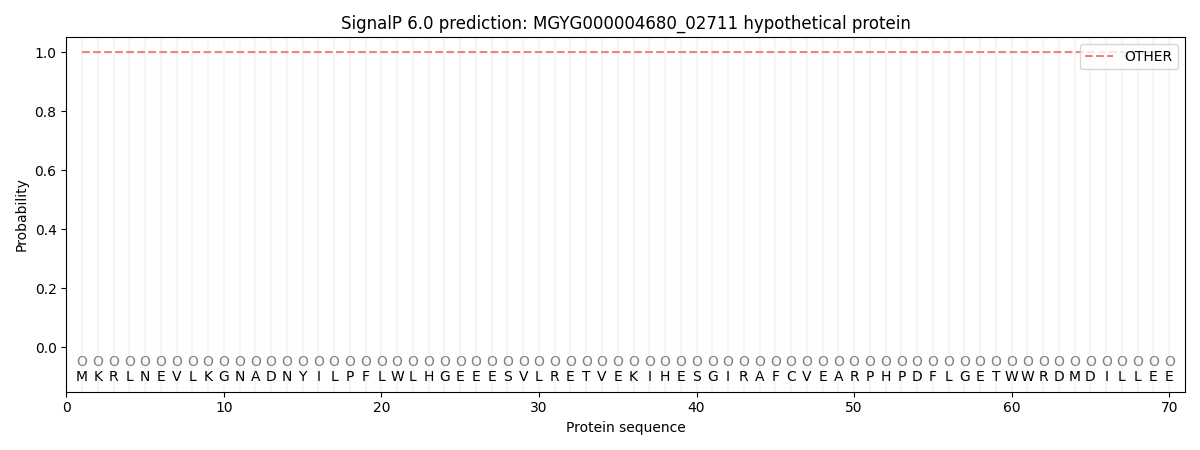You are browsing environment: HUMAN GUT
CAZyme Information: MGYG000004680_02711
You are here: Home > Sequence: MGYG000004680_02711
Basic Information |
Genomic context |
Full Sequence |
Enzyme annotations |
CAZy signature domains |
CDD domains |
CAZyme hits |
PDB hits |
Swiss-Prot hits |
SignalP and Lipop annotations |
TMHMM annotations
Basic Information help
| Species | ||||||||||||
|---|---|---|---|---|---|---|---|---|---|---|---|---|
| Lineage | Bacteria; Firmicutes_A; Clostridia; Lachnospirales; Lachnospiraceae; Lacrimispora; | |||||||||||
| CAZyme ID | MGYG000004680_02711 | |||||||||||
| CAZy Family | GH106 | |||||||||||
| CAZyme Description | hypothetical protein | |||||||||||
| CAZyme Property |
|
|||||||||||
| Genome Property |
|
|||||||||||
| Gene Location | Start: 8787; End: 11375 Strand: - | |||||||||||
CAZyme Signature Domains help
| Family | Start | End | Evalue | family coverage |
|---|---|---|---|---|
| GH106 | 30 | 831 | 1.6e-68 | 0.9101941747572816 |
CDD Domains download full data without filtering help
| Cdd ID | Domain | E-Value | qStart | qEnd | sStart | sEnd | Domain Description |
|---|---|---|---|---|---|---|---|
| pfam02837 | Glyco_hydro_2_N | 7.54e-04 | 763 | 827 | 66 | 133 | Glycosyl hydrolases family 2, sugar binding domain. This family contains beta-galactosidase, beta-mannosidase and beta-glucuronidase activities and has a jelly-roll fold. The domain binds the sugar moiety during the sugar-hydrolysis reaction. |
| cd13300 | PH1_TECPR1 | 0.001 | 637 | 690 | 47 | 95 | Tectonin beta-propeller repeat-containing protein 1 Pleckstrin homology (PH) domain, repeat 1. TECPR1 is a tethering factor involved in autophagy. It promotes the autophagosome fusion with lysosomes by associating with both the ATG5-ATG12 conjugate and phosphatidylinositol-3-phosphate (PtdIns3P) present at the surface of autophagosomes. TECPR1 is also involved in selective autophagy against bacterial pathogens, by being required for phagophore/preautophagosomal structure biogenesis and maturation. It contains 2 DysFN (Dysferlin domains of unknown function, N-terminal), 2 Hyd_WA domains that is a probably beta-propeller, a PH-like domain, a TECPR domain, and a DysFC (C-terminal). The PH domain mediates the binding to phosphatidylinositol-3-phosphate (PtdIns3P). Binding to the ATG5-ATG12 conjugate exposes the PH domain, allowing the association with PtdIns3P. PH domains have diverse functions, but in general are involved in targeting proteins to the appropriate cellular location or in the interaction with a binding partner. They share little sequence conservation, but all have a common fold, which is electrostatically polarized. Less than 10% of PH domains bind phosphoinositide phosphates (PIPs) with high affinity and specificity. PH domains are distinguished from other PIP-binding domains by their specific high-affinity binding to PIPs with two vicinal phosphate groups: PtdIns(3,4)P2, PtdIns(4,5)P2 or PtdIns(3,4,5)P3 which results in targeting some PH domain proteins to the plasma membrane. A few display strong specificity in lipid binding. Any specificity is usually determined by loop regions or insertions in the N-terminus of the domain, which are not conserved across all PH domains. PH domains are found in cellular signaling proteins such as serine/threonine kinase, tyrosine kinases, regulators of G-proteins, endocytotic GTPases, adaptors, as well as cytoskeletal associated molecules and in lipid associated enzymes. |
CAZyme Hits help
| Hit ID | E-Value | Query Start | Query End | Hit Start | Hit End |
|---|---|---|---|---|---|
| AQR97289.1 | 0.0 | 1 | 859 | 1 | 861 |
| AGF58598.1 | 0.0 | 1 | 859 | 1 | 861 |
| AIY07063.1 | 0.0 | 1 | 859 | 1 | 888 |
| APQ61832.1 | 0.0 | 1 | 854 | 1 | 865 |
| AHM66104.1 | 0.0 | 1 | 838 | 1 | 867 |
PDB Hits download full data without filtering help
| Hit ID | E-Value | Query Start | Query End | Hit Start | Hit End | Description |
|---|---|---|---|---|---|---|
| 5MQM_A | 8.79e-07 | 172 | 830 | 390 | 1056 | Glycosidehydrolase BT_0986 [Bacteroides thetaiotaomicron],5MQN_A Glycoside hydrolase BT_0986 [Bacteroides thetaiotaomicron] |
| 5MWK_A | 8.79e-07 | 172 | 830 | 390 | 1056 | Glycosidehydrolase BT_0986 [Bacteroides thetaiotaomicron] |
Swiss-Prot Hits help
SignalP and Lipop Annotations help
This protein is predicted as OTHER

| Other | SP_Sec_SPI | LIPO_Sec_SPII | TAT_Tat_SPI | TATLIP_Sec_SPII | PILIN_Sec_SPIII |
|---|---|---|---|---|---|
| 1.000054 | 0.000000 | 0.000000 | 0.000000 | 0.000000 | 0.000000 |
